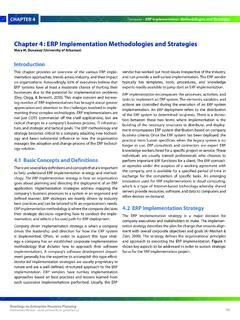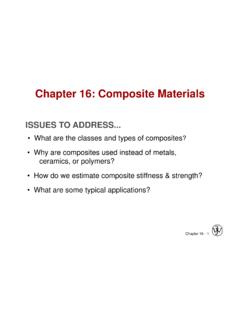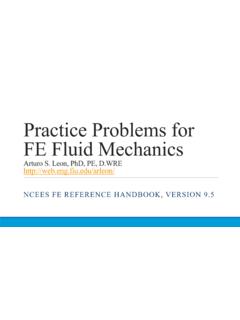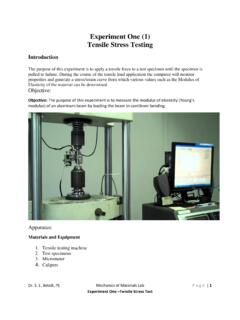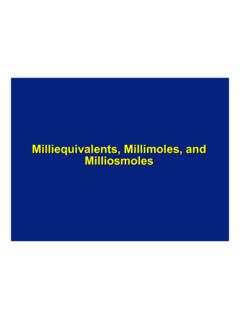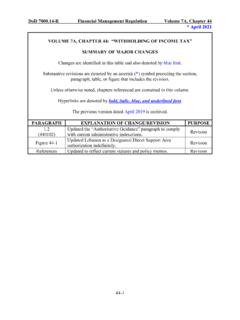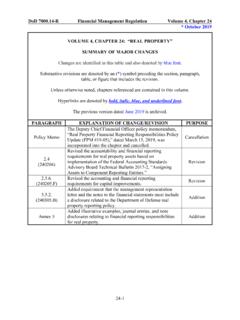Transcription of Chapter 2. Atomic Structure and Interatomic Bonding
1 1/14/2011. Chapter 2. Atomic Structure and Interatomic Bonding Interatomic Bonding Bonding forces and energies Primary Interatomic bonds Secondary Bonding Molecules Bonding Forces and Energies Considering the interaction between two isolated atoms as they are brought into close proximity from an infinite separation. At larger distances, the interactions are negligible. As the atoms approach, each exerts forces on the other. Attractive Repulsive Ultimately, the outer electron shells of the two atoms begin to overlap, and a strong repulsive force comes into play. 1. 1/14/2011. Bonding Models Bonding holds atoms together to form solids materials In solids, atoms are held at preferred distances from each other (equilibrium distances). Distances larger or smaller than equilibrium distances are not preferred.
2 Equilibrium spacing r0 is approximately Consequently, as Atomic bonds are stretched, atoms tend to attract each other, and as the bonds are compressed, atoms repel each other. Simple Bonding models assume that the total Bonding results from the sum of two forces: an attractive force (FA ) and a repulsive (FR). the net force F N = F A + F R. The repulsive force dominates at small distances, and the attractive force dominates at larger distances. At equilibrium they are just equal. Bonding Forces and Energies It is convenient to work with energy than forces. Bonding energy (also called interaction energy or potential energy). between two isolated atoms at separation r is related to the force by The total energy has a minimum at the point of equilibrium separation.
3 Bonding energy E0 corresponds to the energy at ro the energy that would be required to separate these two atoms to an infinite separation. Interpretation: holding one atom at the origin, a second atom would repel that atom at separation r < ro and attract it when ro< r. 2. 1/14/2011. Bonding energy between two atoms The interaction energy at equilibrium is called the Bonding energy between the two atoms. To break the bond, this energy must be supplied from outside. Breaking the bond means that the two atoms become infinitely separated. In real materials, containing many atoms, Bonding is studied by expressing the Bonding energy of the entire materials in terms of the separation distances between all atoms, see later discussion. Bonding Primary Bonding : Ionic (transfer of valence electrons).
4 Covalent (sharing of valence electrons, directional). Metallic (delocalization of valence electrons). Secondary or van der Waals Bonding : (Common, but weaker than primary Bonding ). Dipole-dipole H-bonds Polar molecule-induced dipole Fluctuating dipole (weakest). 3. 1/14/2011. Ionic Bonding Occurs between + and - ions. Requires electron transfer. Large difference in electronegativity required. Example: NaCl Nondirectional 3p 3s 3p 3s Na Cl ( = ) ( = ). Ionic Bonding z1 z2 e 2. EA =. 4 o r Since z1 = +1 for Na+ and z2 = -1 for Cl- e2 A Negative energy means attraction only. EA = = Will the atoms collapse on themselves? 4 o r r No, there is also repulsive energy ( steric repulsion, e-e repulsion). B B and n depend on atoms involved. ER = In many cases n ~ 8.
5 Rn 4. 1/14/2011. Ionic Bonding E. B. ER =. rn r Bond energy A. EA = . r Equilibrium bond length Note: Other types of bonds can also be described in a similar manner Ionic Bonding : examples Predominant Bonding in Ceramics ,-2. $) $. ( # 2. )! )' "' ! ,- !* )$ "! / 1 #. !% )! )' )0 )% )% )% $! $%.. &. !% )! $'. #. !+ !* $$. !+ !*. 3 34 - $ +5 0 - $+ 3 34 ( 6 -5 /7 4 7. 7 # 35 " 3 3 5 8 -7 )*"* 3 )* !5 " 3 3 8 -7 )*0! 8. 9 8. 0 : 5. 1/14/2011. Bonding Energies and Melting Temperatures for Various Substances Covalent Bonding Molecular orbitals Sharing of electrons Why do some atoms want to share electrons? 1s 1s Example1: H2. H H. Atomic orbitals H H. Example2: CH4. C: has 4 valence e, shared electrons H. from carbon atom needs 4 more CH 4.
6 H: has 1 valence e, H C H. needs 1 more Electronegativities shared electrons H from hydrogen are same or comparable. atoms 3 34 - $ )!5 0. 6. 1/14/2011. Atomic orbitals for carbon: 2p 4 valence electrons but two 2s different types orbitals. H's on CH4 should be 1s equivalent. Atomic Orbitals the three p orbitals an s-orbital px py pz z y x sp3 hybridization for C in CH4. Hybridization 1s + 1p = sp-orbitals 1s + 2p = sp2-orbitals 1s + 3p = sp3-orbitals z z z 60 . y y y x x 60 . x Examples: Covalent Bonding $2. &;. $ $. 3 3. $). (.. 2. $. #. )! )' $' $! ! ,- . !* )$ )% "! / 1 #. !% )! )' )0 )% )% )% )0 )% $! $%.. &. !% )! )% $'. # 6. !+ !* )% $$. !+ !* 3 34 - $ +5 0 - $+. 3 34 ( 6 -5 /7 4 7 7 # 35 " 3 3 5 8 -7. )*"* 3 )* !5 " 3 3 8 -7 )*0!
7 8 9 8. 0 : Molecules with nonmetals Molecules with metals and nonmetals Elemental solids (RHS of Periodic Table). Compound solids (about column IVA). 7. 1/14/2011. % ionic character The covalent bond is directional. The number of covalent bonds that is possible for a particular atom is determined by the number of valence electrons. Most bonds between two different types of atoms are somewhere in between ionic and covalent. Very few compounds exhibit pure ionic or covalent Bonding . % ionic character ={1 exp[ ( A B ) 2 ]} 100. j = electronegativity of atom j Example problem Order the following semiconductors from most covalent to most ionic. 1) ZnS, GaP, CuCl 2) ZnS, ZnSe, ZnO. 8. 1/14/2011. Metallic Bonding Arises from a sea of donated valence electrons Fixed ion cores (nuclei and inner electrons).
8 Sea of electrons 3 34 - $ ))5 0. Primary bond for metals and their alloys. Large Atomic radius and small IP will more likely lead to metallic Bonding . Metallic Bonding Valence electrons are completely delocalized to form an electron cloud, in which positive ionic cores are embedded. The remaining nonvalence electrons and Atomic nuclei form ion cores , which posses a net positive charge equal in magnitude to the total valence electron charge per atom. The metallic bond is nondirectional. Metallic Bonding is found in the periodic table for Group IA and IIA. elements. Electron delocalization is the origin of good electrical and thermal conductivities in metals. (Ionically and covalently bonded materials are typically electrical and thermal insulators, due to the absence of large numbers of free electrons).
9 9. 1/14/2011. Secondary Bonds: Intermolecular Forces Secondary, Van der Waals, or physical bonds are weak in comparison to the primary bonds. Secondary Bonding exists between virtually all atoms or molecules, but its presence may be obscured if any of the three primary Bonding types is present. Secondary Bonding forces arise from Atomic or molecular dipoles. An electric dipole exists whenever there is some separation of positive and negative portions of an atom or molecule. Dipole interactions occur between induced dipoles, between induced dipoles and polar molecules (which have permanent dipoles), and between polar molecules. Hydrogen Bonding , a special type of secondary Bonding , is found to exist between some molecules that have hydrogen as one of the constituents.
10 Secondary Bonds: Intermolecular Forces Dipole-dipole interaction: secondary bond between molecules with permanent dipole moments 3 8 Adapted from Fig. , -general case: 3 - Callister 6e. 3 8 Adapted from Fig. , -ex: liquid HCl 3 - Callister 6e. -ex: polymer 3 8. 3 - From Callister 6e resource CD. Hydrogen Bonding O. H H. O. H H. O H. H. 10. 1/14/2011. Polar molecule-induced dipole interaction: Polar molecules (with asymmetric arrangement of positively and negatively charged regions) can induce dipoles in adjacent nonpolar molecules + + - - - +. secondary Nonpolar Bonding polar ( atom). Fluctuating dipoles Constant vibrational motion can cause distortions of electrical symmetry 8 <= 3 $. 3 $ $. 3 8 3 8. 3 - 3 - Adapted from Fig. , Callister 6e.
